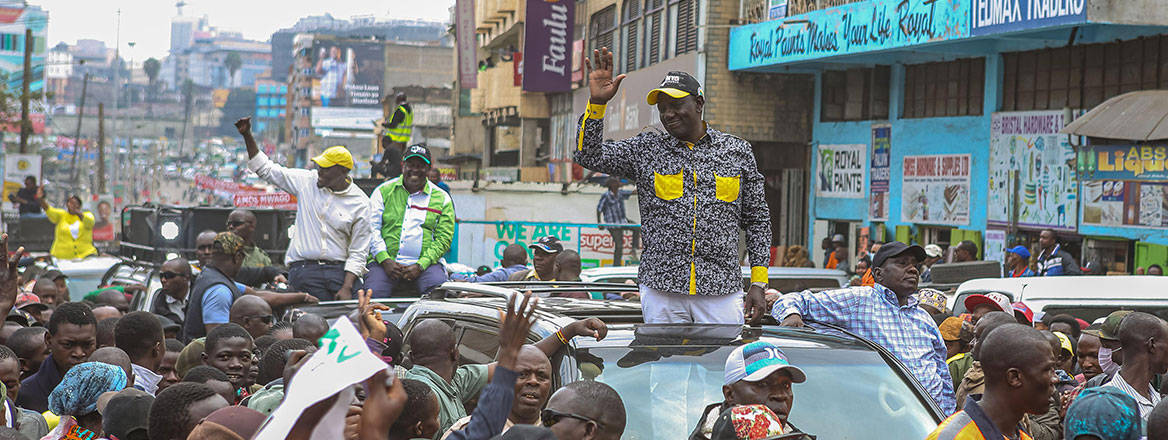Much of the analysis surrounding Kenya’s upcoming elections, especially that in the international media, has focused on what could go wrong following the polls. While acknowledging the warnings, there are several causes for optimism, at least with regards to the elections themselves and the immediate aftermath.
Kenyans go to the polls on 9 August to vote for a new president. The public will also elect members of parliament, as well as governors, senators, women’s representatives and assembly members for each of the fledgling 47 county administrations. With the largest economy in East Africa, Kenya’s stability is critical for the region, but elections here bring uncertainty and anxiety domestically, regionally and internationally.
Fear of post-electoral violence stems from historical precedent. Public disorder has been reported in almost every election since the return of multi-party democracy in 1992, with politicians exploiting ethnic identities and land grievances to secure votes. In 2007–8, Kenya was taken to the brink following a disputed poll; demonstrations descended into widespread ethnic violence that resulted in more than 1,000 deaths and left as many as half a million displaced. A new constitution was subsequently promulgated, primarily in an attempt to reduce the overwhelming focus on the presidential election and the ‘winner-takes-all’ system. A portion of power was devolved to 47 new county governments. Though nationwide unrest was avoided during the elections of 2013 and 2017, both were marred by allegations of fraud, resulting in violent protests in several parts of the country.
There will be four names on the presidential ballot on 9 August; only two are serious contenders. In a peculiar arrangement, the outgoing incumbent Uhuru Kenyatta – son of the country’s first president – is backing Raila Odinga – son of the first vice-president – against his own deputy, William Ruto. The deputy president has adopted the role of opposition candidate following a public falling out with Kenyatta in recent years. Ruto – who leads the Kenya Kwanza coalition and is running on a United Democratic Alliance ticket – is marketing himself as the ‘hustler’ and a ‘man of the people’, determined to defeat the ‘dynasties’ that have dominated Kenyan politics since independence. Odinga, running for a fifth and likely final time – as leader of the Azimio la Umoja coalition – is banking on an anti-corruption agenda, together with perceptions that his pragmatic approach to politics is the best option for a country grappling with unsustainable public debt and rising food prices. Polls have suggested that the race is incredibly close, with the possibility that neither candidate will obtain the 50%-plus-one vote necessary to secure the presidency in the first round.
The tightness of the contest alone has many concerned. The International Crisis Group, for example, concentrated much of its pre-election briefing on the bitter disputes between the main candidates. On this basis, one might argue that devolution has failed in its primary objective, with the presidency remaining the be-all and end-all of electoral politics. However, as powerful as the national government executive remains, this argument perhaps understates the importance of the devolved structures and the dispersal of tensions to county-level contests.
As is always the case shortly before an election in Kenya, organised criminal gangs have re-emerged in disparate parts of the country, with analysts linking them to politicians willing to pay vulnerable youths to disrupt their opponents’ campaigns. Indeed, cases have been reported in which campaign agents have been assaulted by groups of youths during political rallies. Ethnic violence has also increased in some of the more marginalised parts of the country. In the expansive northern county of Marsabit, for example, a spike in clan violence has been linked to the race for the gubernatorial seat. However, incidents have largely remained isolated at the county level.
Between January and June 2022, there was a 75% decrease in incidents of politically motivated public disorder nationwide compared to the same period in 2017
In absolute terms, there has been a significant decrease in political violence in advance of the polls. Under REINVENT, a UK-funded community security programme, RUSI maintains an extensive database of security incidents. The statistics are striking (see Figure 1 below). Between January and June 2022, there was a 75% decrease in incidents of politically motivated public disorder nationwide compared to the same period in 2017. Ultimately, there has been a reduction in the intensity, frequency and geographical spread of incidents in the lead-up to election day. There does not appear to be an appetite for violent means, at least among the presidential candidates. When Odinga’s campaign helicopter was stoned by a group of rival supporters in April, Ruto publicly criticised those responsible and issued an apology. With Ruto and Kenyatta both previously indicted by the International Criminal Court in connection to the 2007–8 post-election violence, the two sides are acutely aware of how their conduct might be perceived.
Figure 1: Incidents of politically motivated public disorder by month, 2017 vs 2022
Source: REINVENT programme violence monitoring data
The doomsayers have also pointed to the fact that the Independent Electoral and Boundaries Commission (IEBC) is not as ready or as well-resourced as it could be. In particular, the institution has failed to implement all the recommendations made by the Supreme Court when it declared the initial 2017 elections ‘null and void’. Efforts by the IEBC in early 2022 to force through changes to election legislation were rejected by parliament. Both leading candidates have expressed concern over the IEBC’s preparations, with particular uncertainty over the voter register and the system in place to transmit results. Procedural controversies could lead to unease among the electorate.
Crucially, however, there are signs of growing confidence in the institutions responsible for managing these elections. A recent study by TIFA, a polling organisation, suggested that ‘complete confidence’ in the IEBC stood at 60%, with only 17% ‘not confident at all’. Critically, there was minimal difference in these figures across the main party divide. Unlike last time, there have been no public protests against the IEBC, and neither of the two main candidates have launched a sustained attack on the institution’s independence. The links that both sides are perceived to enjoy with the establishment mean that any accusations could be seen as self-defeating.
While criticisms of the IEBC’s failure to fully implement the Supreme Court’s recommendations are valid, the IEBC has implemented several new measures to prevent electoral fraud. The digital voter register will include the use of QR codes; every ballot paper slip will contain a security code to prevent duplication; polling stations with poor internet access will be provided with modems; and extra digital kits will be supplied to constituencies in case of failure. The IEBC has listened to the concerns of candidates, inviting them to briefings and updating them on preparations.
There are similarly positive signs that the judiciary is enjoying greater public respect than ever before. If the decision to overturn the results of the first 2017 elections was evidence of the Supreme Court’s growing independence from the executive, then this was further cemented by the court’s ruling against efforts by Kenyatta and Odinga to amend the constitution in mid-2021. These judgments have bolstered the court’s reputation and make it more likely that the losing candidate will seek legal redress rather than calling supporters out onto the streets.
Disinformation may be able to generate discontent, but social media can equally be used to spread messages of peace and serve as a conflict early warning system
Another oft-cited potential cause for concern is a historically heavy-handed police force. Yet, there is evidence that Kenya’s law enforcement agencies are better prepared than ever before. When tensions have escalated at political gatherings, police have adopted proven public order management practices rather than resorting to the use of excessive force. Granted, such restraint has been inconsistently applied across the country, but efforts have been made by the police service to work more closely with the IEBC, and additional personnel have been drawn from the other law enforcement services to ensure that every polling station is adequately secured. Further, the Ministry of Interior has responded to a report on violence ‘hotspots’ released by the National Cohesion and Integration Commission, dedicating additional resources to areas of concern.
Unsurprisingly, significant attention has been paid to the growing role of social media, which is used to spread disinformation. However, although the use of social media in Kenya may be growing rapidly, the majority of voters do not have access to these platforms. Besides, disinformation may be able to generate discontent, but social media can equally be used to spread messages of peace and serve as a conflict early warning system. Greater awareness of the dangers of social media has led to substantial efforts to mitigate its potential impact. Meta, for example, has established a Kenya Elections Operation Centre, working to remove harmful content and protect vulnerable candidates.
But perhaps the most significant cause for optimism is the evidence that ethnicity may be less critical this year, at least when it comes to the presidential vote. While it is true that the formation of coalitions remains motivated by the capture of ethnic voting blocks, the main alliances include key figureheads from across the country’s larger ethno-linguistic communities. With both candidates selecting a Kikuyu running mate, the Mount Kenya vote will be divided for the first time in 20 years. Despite hailing from different communities, there is little history of animosity between Odinga and Ruto, and ultimately there has been a lack of divisive ethnicity-based rhetoric from the candidates. Indeed, there is evidence that, with the economy being the main grievance, at least some sections of the electorate will vote based on issues, not tribe. This could be a significant factor in lowering tensions.
So, What Does this Mean?
The assertion here is not that the elections will be entirely peaceful. With elections taking place across six levels of government, there are bound to be disputes, but a preoccupation with drivers of violence can become a self-fulfilling prophecy. The reality is that widespread violence, especially that which could lead to a national breakdown of public order, is unlikely.
The election itself may not present the trigger for violence that some have anticipated, but significant tensions may emerge further down the line. With debt repayments accounting for at least 60% of tax revenue, the shilling at its lowest-ever level against the US dollar and drought likely to drive up the cost of living even further, frustrations are only likely to grow. Considering the lack of funds available, the new president will struggle to deliver on their campaign promises to young, disaffected voters. But the discrepancy between electoral promises and delivery is hardly just a Kenyan problem.
The views expressed in this Commentary are the author’s, and do not represent those of RUSI or any other institution.
Have an idea for a Commentary you’d like to write for us? Send a short pitch to commentaries@rusi.org and we’ll get back to you if it fits into our research interests. Full guidelines for contributors can be found here.
WRITTEN BY
Christopher Hockey
Senior Research Fellow
RUSI Nairobi
- Jim McLeanMedia Relations Manager+44 (0)7917 373 069JimMc@rusi.org


